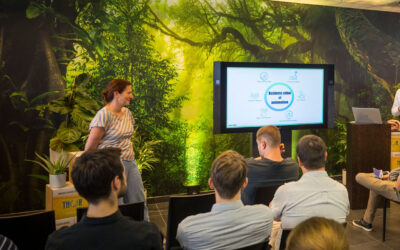After more than two months of working from home due to the coronavirus pandemic, the offices of Ferranti in Antwerp have reopened on June 2nd. The work environment has been adapted according to the requirements, so employees can work safely and without worry. “We thought really hard about how we would handle all this”, facility manager Eva Van Raes says. “Our measures are well-thought-out and with regard to everyone’s safety.”
Ferranti had already implemented a few safety measures before the government and the National Security Council announced their rules regarding social distancing. “We had already canceled the sandwich delivery and asked everyone to eat at their desks, instead of having lunch in larger groups”, Van Raes says. “And, of course, we made sure that there were extra bottles of soap everywhere, so employees could wash their hands more frequently.”
As the corona situation became more serious, Ferranti employees were encouraged to work from home. “Most people were already used to working from home once or twice a week, but we told people they could work from home all week if they wanted”, the facility manager explains. “For others, it was a bit of an adjustment. A few employees took home their office computer screen or keyboard, for lack of a setup of their own. When the news about COVID-19 became even more grim, we noticed most employees took us op on our offer and stayed home. In the end, we decided to close our offices on March 23d.”
Townhall calls and Easter eggs
Of course, the entire company kept in touch during these challenging times. Employees had a chance to listen in to so-called ‘townhall calls’, where they could hear announcements from their management, follow-up on financial figures, or be kept in the loop on the current state of certain projects. “We encouraged every team to keep in touch with all their team members. Before the pandemic, our MECOMS department would open the ‘MECOMS café’ every last Friday of the month in our Antwerp office building. It’s a fun moment for employees to have a drink and a chat with colleagues. We told them they should definitely keep doing that by means of video calls”, Van Raes explains. “It was important to us that these social bonds would be maintained.” The marketing department didn’t forget about their colleagues either and sent Easter eggs to give employees a little pat on the back during hard times.
Floor plans
When the news came that people would soon be allowed to go back to work, Van Raes teamed up with the prevention advisor and HR director. All three of them shifted up a gear or two to get the offices ready for work again. “We had numerous meetings to discuss our course of action. Eventually, we just grabbed the floor plans and checked every nook and corner, looking for space we could or couldn’t use, always keeping the social distancing rules in mind.”
Of the almost 400 desks, there are only about 120 left. “Employees have to reserve a seat beforehand. If you don’t book a desk, you work from home”, Van Raes explains. “Desks that are off-limits have a clear sign indicating they are unavailable. Desks where employees are allowed to work have a place mat on them. If it’s turned over, it means the desk needs cleaning. If it isn’t, it’s ready for a work session. Of course, every workspace is cleaned daily.” There are face masks and rubber gloves for people to use, too. “It’s not an obligation to wear them around the office, but for those who feel more comfortable or safe with a mask or a pair of gloves, the items are free to grab.” On top of that, the coffee corners are all equipped with extra disinfectant wipes.
The biggest adjustments of all were infrastructural. “We had a maintenance check on our air conditioning, and we turned up the ventilation. That way the air circulates much faster, which lowers the risk of contagion”, Van Raes says. “We also made a few doors automatic, so people don’t have to touch the handle. For other doors, we’ve added handsfree handles. Now you can just use your elbow to open the door.”
Circulation plan
And then there’s the big circulation plan to regulate ‘traffic’ in the entire building. “We really thought hard about how we could guarantee the 1,5-meter distance between people. With our circulation plan, we have made sure nobody has to pass one other when entering or exiting the building, or when going from one floor to another.” Arrows on the floor indicate the right way to walk. That means that people have to take a detour to get to a different place in the building, but according to Van Raes “that’s the only way to ensure the implementation of the distancing rule.”
Working from home is still the basic rule for Ferranti, but Van Raes notices that more and more people find their way back to the office every week. “I think a lot of people are happy to be back. Having face-to-face contact with colleagues and a different workspace after so many weeks at home means a lot. We see that people are confident to return to the office again.”



